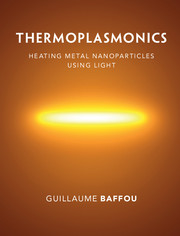Book contents
- Frontmatter
- Dedication
- Contents
- Foreword
- Preface
- 1 Nanoplasmonics
- 2 Thermodynamics of Metal Nanoparticles
- 3 Numerical Simulation Techniques
- 4 Thermal Microscopy Techniques
- 5 Thermal-Induced Processes
- 6 Applications
- Appendix A Dimensional Analysis
- Appendix B Thermodynamical Constants
- Appendix C Thermal Green's Function for a Three-Layer System
- Index
- References
1 - Nanoplasmonics
Published online by Cambridge University Press: 26 October 2017
- Frontmatter
- Dedication
- Contents
- Foreword
- Preface
- 1 Nanoplasmonics
- 2 Thermodynamics of Metal Nanoparticles
- 3 Numerical Simulation Techniques
- 4 Thermal Microscopy Techniques
- 5 Thermal-Induced Processes
- 6 Applications
- Appendix A Dimensional Analysis
- Appendix B Thermodynamical Constants
- Appendix C Thermal Green's Function for a Three-Layer System
- Index
- References
Summary
This introductory chapter deals with basic, general and important notions in nanoplasmonics that will be useful before entering the field of thermoplasmonics. The aim is to provide the reader with simple ideas and mathematical expressions that can be used to explain and understand the plasmonic response of metal nanoparticles.
The first section introduces the physics of the localized plasmon resonance for a dipolar spherical metal nanoparticle, for which closed-form expressions of the optical response exist. The section also describes what happens when enlarging the size of the nanoparticle or breaking its spherical symmetry. The second section explains why gold nanoparticles have been preferred in plasmonics compared with nanoparticles made of other materials. This second section also takes the opportunity to discuss a very recent branch of nanoplasmonics aiming to try and find alternative plasmonic materials. Finally, a third section introduces the field of thermoplasmonics by answering common experimental questions.
Localized Plasmon Resonance
Definitions
A localized plasmon (LP) is a normal mode of collective oscillation of the free electrons contained in a metal nanoparticle. A LP resonance can be excited using light when the electric field of the incoming light oscillates at a frequency close to the plasmon eigen frequency [49].
What I call a localized plasmon (LP) in this book is often coined localized surface plasmon (LSP) in the literature. I prefer to remove the word “surface” for the following reason. Apart from LP, there exist bulk plasmons (BP) and surface plasmons (SP). With a bulk plasmon, the excitation occurs in a metal extending over the three dimensions of space (3D). With a SP, the electronic oscillation occurs at the interface between a metal and a dielectric extending over two dimensions of space (2D). With a LP, the oscillation occurs in a space that is confined in all dimensions of space (0D). While “bulk” means 3D, “surface” means 2D, I find it appropriate to use the adjective “localized” to signify 0D, and not “localized surface.”
In this book, I distinguish between the fields of plasmonics and nanoplasmonics. While plasmonics encompasses the physics of LPs and SPs, nanoplasmonics rather focuses on LPs; hence the title of this chapter.
- Type
- Chapter
- Information
- ThermoplasmonicsHeating Metal Nanoparticles Using Light, pp. 1 - 35Publisher: Cambridge University PressPrint publication year: 2017



